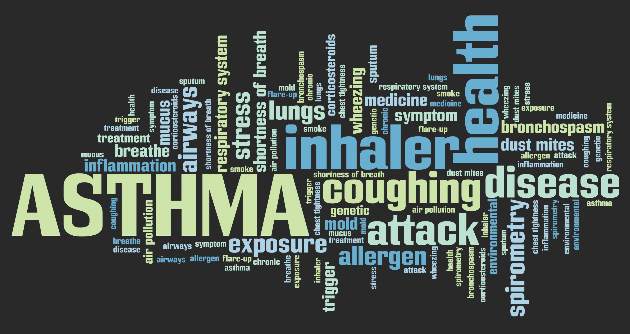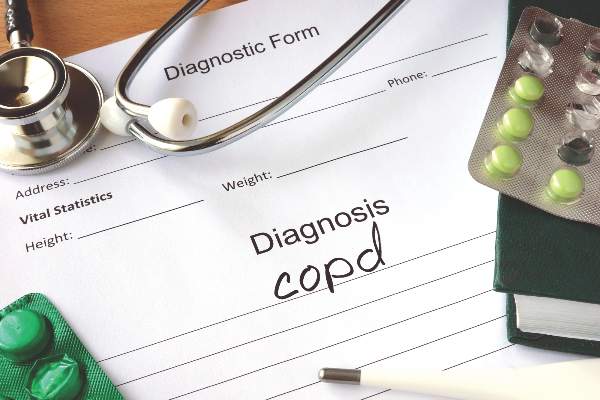User login
LABA withdrawal does not worsen asthma control
LONDON – Real-life experience shows that stopping treatment with a long-acting beta-agonist (LABA) does not worsen asthma control, nor does it lead to any immediate decline in lung function.
Spirometric parameters were similar before and 3 weeks after stopping LABA therapy in an observational study of 58 patients who had stable asthma and were being treated with an inhaled corticosteroid (ICS) and a LABA.
The forced expiratory volume in 1 second (FEV1) was 88.8% at baseline and 89.5% at the 3-week visit after stepping down their LABA therapy (P = .55). Patients’ average peak expiratory flow rate was 462 L/min both before and after LABA withdrawal.
In addition, no changes were seen in lung function based on impulse oscillometry, a noninvasive method for measuring airway resistance and reactance (Chest. 2014;146[3]:841-7). Similar levels of fractional exhaled nitric oxide (FeNO, 38 and 36 ppb) were recorded.
The findings were presented at the annual congress of the European Respiratory Society (ERS) and have been published in an early online edition of the Annals of Allergy, Asthma & Immunology (doi: 10.1016/j.anai.2016.07.022).
“About 45% of the UK adult asthma population are taking step 3 GINA [Global Initiative for Asthma] therapy, which is ICS/LABA,” explained Sunny Jabbal, MD, of the Scottish Centre for Respiratory Research at Ninewells Hospital in Dundee, Scotland, where the study was conducted. Patients should be on the lowest of the five steps in the 2016 GINA guidelines that achieve asthma control and should be regularly reviewed.
To test whether the LABA could be safely withdrawn, that is stepped down to ICS only [GINA step 2], Dr. Jabbal and colleagues studied 58 patients with a mean age of 39 years. All had well-controlled asthma, and had been receiving ICS/LABA for at least 3 months with no asthma exacerbations requiring treatment. None of the patients were current smokers.
At study entry, patients underwent spirometry, impulse oscillometry, and had FeNO measured. Their LABA was then stopped, and patients were reassessed 3 weeks later. “In accordance with GINA, their ICS dose was also reduced by approximately 25%,” Dr. Jabbal said.
Patients recorded their symptoms and short-term reliever (albuterol) use on simple diary cards. They were also given a 24-hour emergency mobile number, but no calls were received and no adverse events reported. The mean daily symptom score recorded during the step down process was 0.4 (out of a possible score of 3), and the mean albuterol usage was one puff per day.
One of the chairs of the session, Omar Usmani, MD, of Imperial College London noted that some clinicians are “very apprehensive” about stopping LABA and stepping down ICS therapy in their patients.
This was a short-term study, Dr. Jabbal acknowledged. Although a follow-up of 3 weeks may be enough to determine the effects of stopping a LABA, that time may not be sufficient to assess the effects of stepping down the ICS. Further real-life studies are needed to evaluate outcomes such as exacerbations and overall quality of life.
Improved adherence with ICS therapy after LABA withdrawal might explain the lack of deleterious effects, or perhaps some patients may not have initially needed an ICS/LABA combination, he speculated. Maybe even the steroid dose could be reduced further in this particular patient population.
The study received no commercial funding. Dr. Jabbal had no conflicts of interest related to his presentation.
LONDON – Real-life experience shows that stopping treatment with a long-acting beta-agonist (LABA) does not worsen asthma control, nor does it lead to any immediate decline in lung function.
Spirometric parameters were similar before and 3 weeks after stopping LABA therapy in an observational study of 58 patients who had stable asthma and were being treated with an inhaled corticosteroid (ICS) and a LABA.
The forced expiratory volume in 1 second (FEV1) was 88.8% at baseline and 89.5% at the 3-week visit after stepping down their LABA therapy (P = .55). Patients’ average peak expiratory flow rate was 462 L/min both before and after LABA withdrawal.
In addition, no changes were seen in lung function based on impulse oscillometry, a noninvasive method for measuring airway resistance and reactance (Chest. 2014;146[3]:841-7). Similar levels of fractional exhaled nitric oxide (FeNO, 38 and 36 ppb) were recorded.
The findings were presented at the annual congress of the European Respiratory Society (ERS) and have been published in an early online edition of the Annals of Allergy, Asthma & Immunology (doi: 10.1016/j.anai.2016.07.022).
“About 45% of the UK adult asthma population are taking step 3 GINA [Global Initiative for Asthma] therapy, which is ICS/LABA,” explained Sunny Jabbal, MD, of the Scottish Centre for Respiratory Research at Ninewells Hospital in Dundee, Scotland, where the study was conducted. Patients should be on the lowest of the five steps in the 2016 GINA guidelines that achieve asthma control and should be regularly reviewed.
To test whether the LABA could be safely withdrawn, that is stepped down to ICS only [GINA step 2], Dr. Jabbal and colleagues studied 58 patients with a mean age of 39 years. All had well-controlled asthma, and had been receiving ICS/LABA for at least 3 months with no asthma exacerbations requiring treatment. None of the patients were current smokers.
At study entry, patients underwent spirometry, impulse oscillometry, and had FeNO measured. Their LABA was then stopped, and patients were reassessed 3 weeks later. “In accordance with GINA, their ICS dose was also reduced by approximately 25%,” Dr. Jabbal said.
Patients recorded their symptoms and short-term reliever (albuterol) use on simple diary cards. They were also given a 24-hour emergency mobile number, but no calls were received and no adverse events reported. The mean daily symptom score recorded during the step down process was 0.4 (out of a possible score of 3), and the mean albuterol usage was one puff per day.
One of the chairs of the session, Omar Usmani, MD, of Imperial College London noted that some clinicians are “very apprehensive” about stopping LABA and stepping down ICS therapy in their patients.
This was a short-term study, Dr. Jabbal acknowledged. Although a follow-up of 3 weeks may be enough to determine the effects of stopping a LABA, that time may not be sufficient to assess the effects of stepping down the ICS. Further real-life studies are needed to evaluate outcomes such as exacerbations and overall quality of life.
Improved adherence with ICS therapy after LABA withdrawal might explain the lack of deleterious effects, or perhaps some patients may not have initially needed an ICS/LABA combination, he speculated. Maybe even the steroid dose could be reduced further in this particular patient population.
The study received no commercial funding. Dr. Jabbal had no conflicts of interest related to his presentation.
LONDON – Real-life experience shows that stopping treatment with a long-acting beta-agonist (LABA) does not worsen asthma control, nor does it lead to any immediate decline in lung function.
Spirometric parameters were similar before and 3 weeks after stopping LABA therapy in an observational study of 58 patients who had stable asthma and were being treated with an inhaled corticosteroid (ICS) and a LABA.
The forced expiratory volume in 1 second (FEV1) was 88.8% at baseline and 89.5% at the 3-week visit after stepping down their LABA therapy (P = .55). Patients’ average peak expiratory flow rate was 462 L/min both before and after LABA withdrawal.
In addition, no changes were seen in lung function based on impulse oscillometry, a noninvasive method for measuring airway resistance and reactance (Chest. 2014;146[3]:841-7). Similar levels of fractional exhaled nitric oxide (FeNO, 38 and 36 ppb) were recorded.
The findings were presented at the annual congress of the European Respiratory Society (ERS) and have been published in an early online edition of the Annals of Allergy, Asthma & Immunology (doi: 10.1016/j.anai.2016.07.022).
“About 45% of the UK adult asthma population are taking step 3 GINA [Global Initiative for Asthma] therapy, which is ICS/LABA,” explained Sunny Jabbal, MD, of the Scottish Centre for Respiratory Research at Ninewells Hospital in Dundee, Scotland, where the study was conducted. Patients should be on the lowest of the five steps in the 2016 GINA guidelines that achieve asthma control and should be regularly reviewed.
To test whether the LABA could be safely withdrawn, that is stepped down to ICS only [GINA step 2], Dr. Jabbal and colleagues studied 58 patients with a mean age of 39 years. All had well-controlled asthma, and had been receiving ICS/LABA for at least 3 months with no asthma exacerbations requiring treatment. None of the patients were current smokers.
At study entry, patients underwent spirometry, impulse oscillometry, and had FeNO measured. Their LABA was then stopped, and patients were reassessed 3 weeks later. “In accordance with GINA, their ICS dose was also reduced by approximately 25%,” Dr. Jabbal said.
Patients recorded their symptoms and short-term reliever (albuterol) use on simple diary cards. They were also given a 24-hour emergency mobile number, but no calls were received and no adverse events reported. The mean daily symptom score recorded during the step down process was 0.4 (out of a possible score of 3), and the mean albuterol usage was one puff per day.
One of the chairs of the session, Omar Usmani, MD, of Imperial College London noted that some clinicians are “very apprehensive” about stopping LABA and stepping down ICS therapy in their patients.
This was a short-term study, Dr. Jabbal acknowledged. Although a follow-up of 3 weeks may be enough to determine the effects of stopping a LABA, that time may not be sufficient to assess the effects of stepping down the ICS. Further real-life studies are needed to evaluate outcomes such as exacerbations and overall quality of life.
Improved adherence with ICS therapy after LABA withdrawal might explain the lack of deleterious effects, or perhaps some patients may not have initially needed an ICS/LABA combination, he speculated. Maybe even the steroid dose could be reduced further in this particular patient population.
The study received no commercial funding. Dr. Jabbal had no conflicts of interest related to his presentation.
AT THE ERS CONGRESS 2016
Key clinical point: Step-down treatment works well in routine asthma care, with no loss of control or lung function decline.
Major finding: No significant changes in FEV1 (88.8% vs. 89.5%), PEF (462 L/min vs. 462 L/min), or other lung function variables were seen before or 3 weeks after LABA withdrawal.
Data source: Observational study of 58 stable asthmatic patients being treated with ICS/LABA (GINA step 3).
Disclosures: The study received no commercial funding. Dr. Jabbal had no conflicts of interest related to his presentation.
Fluticasone furoate/vilanterol edged out usual COPD care in real-world trial
A once-daily inhaled combination of fluticasone furoate and vilanterol was associated with an 8% lower rate of exacerbations in chronic obstructive pulmonary disease (COPD) than was usual care, with no increase in adverse effects, according to a multicenter trial designed to reflect real-world practice.
“Future effectiveness studies [like this one] are likely to influence clinical guidelines, not only for COPD but [also] for many other chronic diseases,” said Jørgen Vestbo, MD, of University Hospital of South Manchester NHS Foundation Trust, Manchester, England, and his associates, for the Salford Lung Study investigators. The findings were presented at the annual congress of the European Respiratory Society and published simultaneously in the New England Journal of Medicine.
Current COPD guidelines are based on clinical trials of carefully selected and monitored patients, which substantially limits their usefulness in everyday practice, the researchers said. To help address that problem, their 12-month, prospective, open-label, parallel-group, randomized study enrolled 2,799 COPD patients in 75 general practices within a single urban area in the United Kingdom. Patients received 100 mcg of fluticasone furoate and 25 mcg of vilanterol or usual care. The primary outcome was the rate of moderate or severe exacerbations among patients who had experienced an exacerbation within 1 year before enrollment. Patients received all treatment from their usual providers and were monitored remotely for safety through electronic health records (N Engl J Med. 2016 Sep 4. doi: 10.1056/NEJMoa1608033).
Fluticasone furoate/vilanterol was associated with 1.74 moderate or severe exacerbations per year, compared with 1.9 events per year with usual-care group, for a statistically significant difference of 8.4% (95% confidence interval, 1.1%-15.2%; P = .02). The trial arms had similar rates of COPD-related health care visits and first moderate or severe exacerbations. They also did not notably differ in terms of serious adverse events of special interest, such as cardiovascular events (which affected 8% of patients in each group) or pneumonia (which affected 7% of fluticasone furoate/vilanterol patients and 6% of usual-care patients). Thirteen patients in each group developed fatal pneumonia, of which one case was considered related to usual care. The only other treatment-related death involved of deep-vein thrombosis and pulmonary embolism in a patient receiving fluticasone furoate/vilanterol.
Medication switches were about twice as common (22%) in the intervention group than in the usual care group (11%), perhaps because of the open-label nature of the trial, the researchers said. Only 4% of patients receiving fluticasone furoate/vilanterol needed better disease control, half the rate of the usual care group.
GlaxoSmithKline funded the trial. Dr. Vestbo reported personal fees from GlaxoSmithKline while the study was conducted.
A once-daily inhaled combination of fluticasone furoate and vilanterol was associated with an 8% lower rate of exacerbations in chronic obstructive pulmonary disease (COPD) than was usual care, with no increase in adverse effects, according to a multicenter trial designed to reflect real-world practice.
“Future effectiveness studies [like this one] are likely to influence clinical guidelines, not only for COPD but [also] for many other chronic diseases,” said Jørgen Vestbo, MD, of University Hospital of South Manchester NHS Foundation Trust, Manchester, England, and his associates, for the Salford Lung Study investigators. The findings were presented at the annual congress of the European Respiratory Society and published simultaneously in the New England Journal of Medicine.
Current COPD guidelines are based on clinical trials of carefully selected and monitored patients, which substantially limits their usefulness in everyday practice, the researchers said. To help address that problem, their 12-month, prospective, open-label, parallel-group, randomized study enrolled 2,799 COPD patients in 75 general practices within a single urban area in the United Kingdom. Patients received 100 mcg of fluticasone furoate and 25 mcg of vilanterol or usual care. The primary outcome was the rate of moderate or severe exacerbations among patients who had experienced an exacerbation within 1 year before enrollment. Patients received all treatment from their usual providers and were monitored remotely for safety through electronic health records (N Engl J Med. 2016 Sep 4. doi: 10.1056/NEJMoa1608033).
Fluticasone furoate/vilanterol was associated with 1.74 moderate or severe exacerbations per year, compared with 1.9 events per year with usual-care group, for a statistically significant difference of 8.4% (95% confidence interval, 1.1%-15.2%; P = .02). The trial arms had similar rates of COPD-related health care visits and first moderate or severe exacerbations. They also did not notably differ in terms of serious adverse events of special interest, such as cardiovascular events (which affected 8% of patients in each group) or pneumonia (which affected 7% of fluticasone furoate/vilanterol patients and 6% of usual-care patients). Thirteen patients in each group developed fatal pneumonia, of which one case was considered related to usual care. The only other treatment-related death involved of deep-vein thrombosis and pulmonary embolism in a patient receiving fluticasone furoate/vilanterol.
Medication switches were about twice as common (22%) in the intervention group than in the usual care group (11%), perhaps because of the open-label nature of the trial, the researchers said. Only 4% of patients receiving fluticasone furoate/vilanterol needed better disease control, half the rate of the usual care group.
GlaxoSmithKline funded the trial. Dr. Vestbo reported personal fees from GlaxoSmithKline while the study was conducted.
A once-daily inhaled combination of fluticasone furoate and vilanterol was associated with an 8% lower rate of exacerbations in chronic obstructive pulmonary disease (COPD) than was usual care, with no increase in adverse effects, according to a multicenter trial designed to reflect real-world practice.
“Future effectiveness studies [like this one] are likely to influence clinical guidelines, not only for COPD but [also] for many other chronic diseases,” said Jørgen Vestbo, MD, of University Hospital of South Manchester NHS Foundation Trust, Manchester, England, and his associates, for the Salford Lung Study investigators. The findings were presented at the annual congress of the European Respiratory Society and published simultaneously in the New England Journal of Medicine.
Current COPD guidelines are based on clinical trials of carefully selected and monitored patients, which substantially limits their usefulness in everyday practice, the researchers said. To help address that problem, their 12-month, prospective, open-label, parallel-group, randomized study enrolled 2,799 COPD patients in 75 general practices within a single urban area in the United Kingdom. Patients received 100 mcg of fluticasone furoate and 25 mcg of vilanterol or usual care. The primary outcome was the rate of moderate or severe exacerbations among patients who had experienced an exacerbation within 1 year before enrollment. Patients received all treatment from their usual providers and were monitored remotely for safety through electronic health records (N Engl J Med. 2016 Sep 4. doi: 10.1056/NEJMoa1608033).
Fluticasone furoate/vilanterol was associated with 1.74 moderate or severe exacerbations per year, compared with 1.9 events per year with usual-care group, for a statistically significant difference of 8.4% (95% confidence interval, 1.1%-15.2%; P = .02). The trial arms had similar rates of COPD-related health care visits and first moderate or severe exacerbations. They also did not notably differ in terms of serious adverse events of special interest, such as cardiovascular events (which affected 8% of patients in each group) or pneumonia (which affected 7% of fluticasone furoate/vilanterol patients and 6% of usual-care patients). Thirteen patients in each group developed fatal pneumonia, of which one case was considered related to usual care. The only other treatment-related death involved of deep-vein thrombosis and pulmonary embolism in a patient receiving fluticasone furoate/vilanterol.
Medication switches were about twice as common (22%) in the intervention group than in the usual care group (11%), perhaps because of the open-label nature of the trial, the researchers said. Only 4% of patients receiving fluticasone furoate/vilanterol needed better disease control, half the rate of the usual care group.
GlaxoSmithKline funded the trial. Dr. Vestbo reported personal fees from GlaxoSmithKline while the study was conducted.
FROM ERS 2016
Key clinical point: A once-daily inhaled combination of fluticasone furoate and vilanterol was associated with statistically fewer COPD exacerbations compared with usual care in a real-world trial.
Major finding: The rate of moderate or severe exacerbations was 8% lower with fluticasone furoate/vilanterol group, compared with usual care (P = .02).
Data source: A 12-month, prospective, randomized open-label study of 2,799 COPD patients seen in general urban practices.
Disclosures: GlaxoSmithKline funded the trial. Dr. Vestbo reported personal fees from GlaxoSmithKline while the study was conducted.



